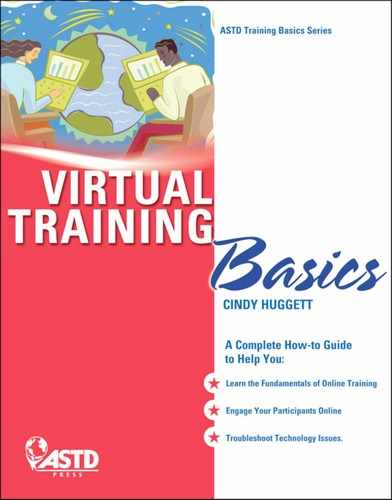4
Master Virtual Classroom
Software Programs
 |
What's Inside This Chapter
In this chapter, you’ll learn |
- How to select a virtual solution
- How to compare virtual classroom software programs
- Virtual class logistics
- Common features of virtual classroom software programs.
Master craftsmen know their tools: carpenters know their hammers and saws, masons know their bricks and mortar, potters know their clay, and trainers should know their virtual classroom software.
Becoming a master of your trade means being an expert in the tools you use—which means virtual trainers simply must learn everything there is to know about the software platform on which they stand. Just like a regular classroom trainer studies presentation skills and flipchart drawing techniques, a virtual trainer should study the software program they will use when delivering.
 |
Think About This |
Virtual classroom software programs bring people together online in real time. These programs allow for collaboration and document sharing.
Selecting a Virtual Solution
Selecting virtual classroom software to use can be a daunting task. It's a big decision to make: Which software platform will you use for training? The features and functions available to you in the virtual classroom depend largely on the software chosen; therefore, it's not a decision to make lightly. For example, if you know that using small-group breakout rooms will be an essential component of your online training, then you want to look for a program that has breakout rooms.
In many organizations, the information technology (IT) department has control over which software programs everyone will use. If that's the case, you should establish a good relationship with the IT decision makers and discuss your training requirements with them. When the IT department purchases a solution, you want it to be one that fits the organization's training needs.
Online virtual collaboration tools often have more than one version with different features for each, and someone outside the training function might not think about what is necessary for a virtual class. For instance, one popular virtual platform, Cisco WebEx, has three versions: Meeting Center, Training Center, and Event Center. While each has a similar look and feel, each one has its own features and capabilities. This is similar to physical meeting space. Think about where different types of training events are held in your office: conference rooms, training classrooms, and auditoriums. Virtual meeting programs have similar types of options.
 |
Basic Rule 7 |
| If you are scheduled to facilitate an online training class, and they tell you which virtual software platform you’ll be using, be sure to ask, “Which version?” | |
So often I hear trainers say, "Our IT department purchased the 'meeting' version of the virtual software, and I'm trying to convince them to upgrade to the 'training' version." Nip this problem in the bud by working together with the IT team to make a purchasing decision that's right for everyone.
Comparing Virtual Classroom Software Programs
There are many competing software programs on the market today that are used for virtual classrooms. These programs are called by various names; some are referred to as online collaboration platforms, others are known as synchronous learning systems, and still others are called web conferencing programs. Since this book focuses on virtual training, I'll refer to them as virtual classroom software programs.
Table 4-1 lists a few of the most common programs currently in use by virtual trainers. Please note that this is not an exhaustive list, and it may not include the right solution for your organization. You should research thoroughly your own delivery needs, compare vendors and solutions, talk with your IT department about resource requirements, and make an informed decision. Most of these programs have trial versions for testing and allow you to participate in online sessions to familiarize yourself with the available features.
In addition to the software program vendors, several third-party vendors re-sell virtual classroom software solutions. These vendors provide additional support services for the programs, such as event management and customer support. They also package together conference calling systems and web conferencing (virtual classroom software) into one bundled solution for subscription purchase by individuals and organizations. When you use these bundled packages, the web and audio conferencing are integrated together.
Some third-party vendors call the software programs by another name. For example, Premiere Global Services, Inc. (www.pgi.com) offers a web conferencing solution called "ReadyCast," which uses Cisco WebEx software in addition to its other services. So, a trainer who delivers a virtual class using ReadyCast would need to learn how to use WebEx.
Another third-party vendor, InterCall (www.intercall.com), also offers web conferencing solutions along with its other professional services. Some of its current services include Cisco WebEx, Microsoft Office Live Meeting, and Adobe Acrobat Connect Pro. Once again, virtual trainers using these InterCall solutions should learn the underlying platforms.
Table 4–1. Selected Virtual Classroom Software Programs
| Name | Webcast | Webinar |
| Adobe Acrobat Connect Pro |
www.adobe.com | A web conferencing program based on the Adobe Flash Player software that can be used for virtual training delivery. It integrates with other Adobe products including Adobe Presenter and Adobe Captivate. |
| Cisco WebEx | www.webex.com | Three versions that can be used for virtual training: Meeting Center, Training Center, and Event Center. Training Center is the preferred version for a virtual training class; however, the other versions also can be used. |
| Citrix GoToWebinar |
www.gotowebinar.com | Online event products, including GoToMeeting and GoToWebinar. GoToWebinar is the preferred version for a virtual training class; however, other versions can also be used. |
| Elluminate Live! |
www.elluminate.com | A virtual environment for learning. It integrates with other Elluminate products such as Elluminate Plan! and Elluminate Publish! |
| Microsoft Live Meeting |
www.microsoft.com/ livemeeting | Online meeting space that can be used as a virtual classroom and integrates with other Microsoft products, including Microsoft Office Outlook. |
The decision to use a third-party vendor versus going straight to the software vendor will depend upon your organization's overall web conferencing needs. On the one hand, if you need both audio and web conferencing, the third-party vendors provide integrated solutions. On the other hand, you may not need all of the services offered through these bundles. It's important for you to research thoroughly and decide appropriately.
 |
Noted: |
Spend time practicing leading the content and working with the technology.
—Rebecca Ward, Training Performance Consultant, AchieveGlobal
Tips for Learning a Virtual Classroom Software Program.
- Read the Help screens in the software program.
- Go through the online tutorials available on the vendor website.
- Participate in user group discussion boards.
- Attend sessions that use the software program as a participant (note: most vendors offer free virtual sessions).
- Practice delivering sessions using the program. Set up multiple "mock" computers, or ask your friends, family, or co-workers to join as participants.
- Log in to a practice virtual event as a participant and click on every button and menu item to find out what each one does. Then do the same thing while logged in to the practice virtual event as the host and/or presenter. This way you will experience every button and every command from all perspectives.
 |
Think About This |
Put some thought into the type of virtual classroom program you will use, and choose
the best platform for your unique needs. For a more in-depth comparison of the programs, check out the following resources:
- eLearning Guild's 360° Research Report "Synchronous Learning Systems," available at
www.elearningguild.com - Training Media Review's "Web conferencing application reviews and ratings," available at www.tmreview.com
Virtual Class Logistics
In order for a synchronous online training class to happen, the event needs to be scheduled using the software program's administration tools. This administrative task establishes parameters such as- class date and time
- duration of the class
- presenter, trainer, or host log in details
- participant log in details
- audio or conference call features.
In addition, depending upon what virtual classroom software you are using, the administrative setup may also determine
- whether or not a participant password will be required to log in
- how early the participants can enter the event
- what entry or lobby screens the participant sees upon log in
- what privileges the participant will have in the session.
 |
Basic Rule 8 |
| The virtual class event setup can dictate which features will be available and who can attend. Be sure you are familiar with your virtual classroom software’s administrative tools. | |
Most virtual classroom software programs are time-driven with a specific date and time for the event. However, for some programs, the administrative setup "generates" the meeting room, which can then be perpetually used from that point forward. For example, when using Adobe Acrobat Connect Pro, the administrator creates an online meeting room, and it can be accessed at any time. This is a useful feature because trainers can set up the room well in advance of the session. In the time-driven event programs, the trainer simply logs in early to set up the session before its start time.
The specific directions on how to schedule the event will vary from vendor to vendor and from program to program. Regardless of who is responsible in your organization for learning administration, you should learn how your software program's administration features work so that you can step in if needed. You'll also have an understanding of what can and cannot be changed for the event.
Part of event administration also includes communicating details to participants. The communication should include
- prerequisites for the course
- assignments to complete prior to the session
- handouts to print prior to the session
- technical or computer system requirements
- computer technology checks that should be completed prior to the session
- connection details for the event.
We'll review more details about communicating with participants in chapter 5.
 |
Think About This |
Most virtual classroom software programs have one log in passcode for the trainer and a separate one for the participants. (Depending on the software program, the trainer code may be called the host code, the presenter code, or the moderator code.) The trainer’s passcode gives the trainer additional permissions and privileges in the software. Therefore, the trainer code should not be shared with participants. However, the trainer should know both codes for the event just in case a participant needs help logging in.
A virtual class has more technical logistics than a face-to-face one, and special care should be taken to ensure all of the details are established and communicated to everyone involved.
A small glitch in the setup of a physical class might not be a big deal, but it could spell disaster for a virtual event. For example, a training class scheduled to be held in Room 107B may be accidentally communicated to participants as Room 107A; when the participants show up to the wrong room, they could easily be redirected to the correct location. And most participants would not think twice about having to walk a few extra steps to get to the right room. However, if virtual class participants are sent the wrong event link to join the online session, we may not have an easy way to communicate the correct connection information to them in a timely manner. And participants who cannot connect to the virtual classroom may quickly give up and abandon joining the class. The incorrect link could have been a simple administrative error, yet it could be perceived as a technical glitch in the system. If this happened, your participants could miss the session, and for those who do arrive, it would be a rocky start to the virtual class.
 |
Think About This |
Take caution with your trainer passcodes. I learned this lesson the hard way when someone logged in to my training session as the host while I was in the middle of the class. It immediately bumped me out of the host role and into a participant role. I lost technical control of the class. I had to send the person a chat message requesting that they log out or at least change my role back to the host. Fortunately, she did so quickly, and I regained technical control of the class.
Later, we found out that two classes had been scheduled at the same time, and another trainer had accidentally received my event host information for her class. She quickly realized the error, logged out, and found her correct class information.
Virtual Classroom Software Roles. Speaking of learning administration, a successful virtual training event needs someone to organize all of its logistics. This person may or may not be the trainer. Just like a face-to-face classroom event, a learning coordinator might be assigned to manage the session details or the trainer could do it all.
There are the four roles required for a successful virtual class:
- administrator (sometimes called coordinator)
- host (sometimes called producer)
- trainer (sometimes called presenter)
- participants (sometimes called attendees).
Review Table 4-2 for a description of each of these roles.
There is often overlap between these roles. One person may wear multiple hats. It's possible for one trainer to act as administrator, host, and presenter. Or, there might be separate individuals available to take on each role.
It is a best practice to have at least two people involved in the administration during a live synchronous event: one person to act as host/producer and another person to act as trainer/presenter. The larger the class size, the more important it is to have multiple people responsible for the event. This shared arrangement allows the trainer to focus on the facilitation, learning, and participant engagement, while the producer focuses on the technical details. For example, if a virtual class has 12 participants, and one of them has a technical challenge, the producer can assist that person while the trainer facilitates discussion with the other 11. The producer and trainer should coordinate ahead of time to explicitly determine who will do what and how the handoffs between them will occur.
Table 4–2. Roles in the Virtual Classroom
| Role | Description |
| Administrator (sometimes called coordinator) |
|
| Host (sometimes called producer) |
|
| Trainer (sometimes called presenter) |
|
| Participants (sometimes called attendees) |
|
Common Features of a Virtual Classroom Software Program
Let's review the common features available in most virtual classroom software programs. We'll briefly discuss each tool, its common uses for virtual training, and any unique characteristics to be mindful of when using it.
Once again, this is not an exhaustive list of all features—just the ones regularly used in virtual training. You should double check with your software program to discover which features it has, what is unique about the tool in that program, and if any software updates have changed its functionality since this book was written.
Sharing Documents. Description: Sharing documents is one of the most commonly used features in a virtual class. The trainer uploads a file into a viewing window and all participants can see it. When the trainer navigates through the document, moving from one page to another, the participants' screens follow along (see Figure 4-1).
Figure 4-1. Sharing Documents in Adobe Acrobat Connect Pro

Source: Adobe® product screenshot reprinted with permission from Adobe Systems Incorporated
Common uses: Almost all virtual training classes use document sharing to display Microsoft Office PowerPoint slides. In addition, other documents, such as training manuals or pages from the class handout, also can be displayed.
Most programs can share Microsoft Office documents (Word, Excel, or PowerPoint), plus Portable Document Format (PDF) files. Some programs allow media files to be shared using this feature.
Unique characteristics: Some programs have participant privilege settings that give the participants free control over viewing the shared documents. This means they could move to a different slide than the one everyone else is viewing. Other programs give you control over whether or not participants can print the shared document. Check to see what privileges your attendees have for viewing shared documents.
Most virtual classroom software programs have a "Sync" or "Synchronize" command that can be used by the presenter to synchronize all participant screens. In other words, if participants are viewing different parts of a shared document, clicking on the Sync command will bring everyone together.
Check for file compatibility with the virtual classroom software: first, that the file type you wish to share can be uploaded, and second, that the version (such as Microsoft Office 2007 versus 2003) of the file you wish to upload is supported by the software.
Note that some virtual classroom software programs use the document-sharing feature to play audio or video files. In some programs, you simply open the media file as a shared document. Other programs require you to embed the media file into a PowerPoint slide using a proprietary add-in.
Chat. Description: Chat enables you to communicate with participants through real-time typed messages, similar to an instant messenger software program (see Figure 4-2). Chat messages can be public so that everyone sees the note, or sent privately to one individual user.
Private chat allows a participant to communicate directly with the host and/or the presenter. For example, I was delivering a virtual class and one of the participants sent me a private note explaining a personal reason why she wasn't able to complete an in-class assignment and requested that I please not call on her to share her answers to it.
Private chat also allows participants to chat with each other. For example, two participants in a training event could communicate with each other by sending messages back and forth in the chat window. In some virtual classroom programs, this conversation would be completely private. Other programs allow the host to see all private conversations.
Figure 4–2. Chat Window in Adobe Acrobat Connect Pro
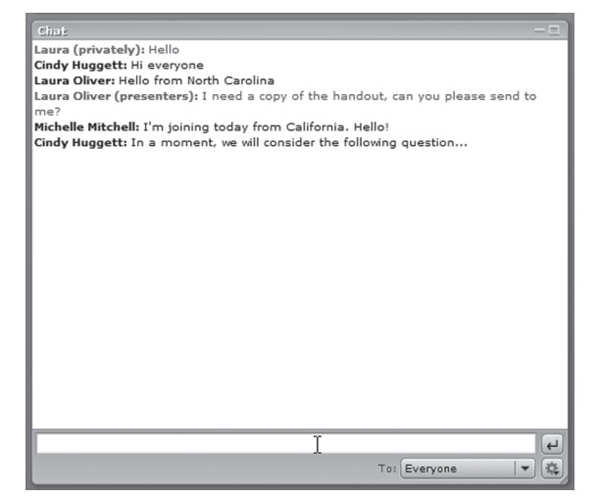
Source: Adobe® product screenshot reprinted with permission from Adobe Systems Incorporated
Common Uses: Chat enables you to engage participants during a training class in meaningful ways. The trainer can invite participants to send feedback, ask questions, and make comments during the program. The chat window can be a running commentary throughout the session.
 |
Think About This |
Proper planning is crucial. If you are co-facilitating with another trainer or working with a producer, plan ahead of time who will monitor the chat window and respond to questions.
To increase participation during a discussion, a trainer could ask a question and direct participants to respond in the chat window. This method allows everyone to respond and get involved with the discussion.
The chat window can also be useful for the trainer to pass messages along to the participants during activities. For example, during a breakout session, the trainer can use the chat window to give timing reminders (such as "three minutes remaining" or "it's time to begin Round 2").
 |
Think About This |
Use all of your tools to communicate with participants and overcome any technical hangups. During one of my recent sessions, my telephone connection to the session unexpectedly dropped mid-sentence. I was still connected visually, just not verbally. So I typed a quick note in the chat area to let everyone know I was dialing right back in.
Private chat could also be used to create a "paired" discussion opportunity in class. Similar to a classroom session where a trainer says, "Turn to the person sitting next to you and discuss your response to this question," a trainer in the virtual classroom could direct participants to have a private chat.
Now, of course, private chat between participants opens up the possibility of them passing notes back and forth between each other, perhaps commenting about the training or their experience. While some trainers shy away from giving participants this type of control, I prefer to allow learners full access to the chat room and encourage them to communicate any way they wish.
 |
Noted: |
I warn participants if you're going to talk about me or someone else in the class via private chat, make sure you're sending the message to the correct person before you click Send.
—Wendy Gates Corbett, Director, Education Services, Learn.com
Unique characteristics: Rules about private chat vary from program to program. In most programs, the host can choose whether or not private chat is allowed, and if it is allowed, whether participants can privately chat with each other (see Figure 4-3).
Figure 4–3. Participant Chat Privileges in Adobe Acrobat Connect Pro
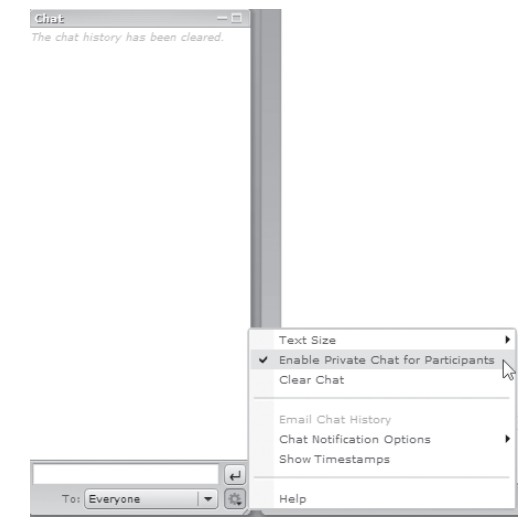
Source: Adobe® product screenshot reprinted with permission from Adobe Systems Incorporated
If your participants include non-native language speakers, extra time may be needed for chatting answers. Some participants do not type as fast as others, which may also affect the timing of chat responses.
In one of my virtual training sessions, we play a trivia game on a topic related to the content and award points to the first person to correctly answer the question. Participants were directed to answer questions via chat. Interestingly, the first name that appeared on my chat window was not the first name on others' chat windows. So when I announced the winner, everyone erupted in protest. We discussed it and decided it was due to Internet bandwidth, although it could have also been user error on my part. We joked about it and turned it into a lighthearted event and learning experience, but it was a good lesson learned. In future sessions, I changed the directions and process for awarding points.
Annotate. Description: The annotation tools allow for real-time "drawing" on top of shared documents or a whiteboard. Annotation adds visual flair to your screen (see Figure 4-4). Annotation also focuses participant attention to specific areas of the screen.
Figure 4–4. Whiteboard Toolbar in Adobe Acrobat Connect Pro

Source: Adobe® product screenshot reprinted with permission from Adobe Systems Incorporated
The exact annotation tools available vary from program to program. However, most allow you to
- draw lines and other shapes
- draw freehand with an electronic pencil or marker
- type text on the screen
- highlight words.
 |
Think About This |
A great virtual trainer should know all the tips and tricks of his or her preferred virtual classroom. Here’s a quick tip that works in most software programs: To draw a perfectly straight line when using the “line” tool, hold down the Shift key while you draw it.
Common uses: The annotation tools help keep the screen visually interesting when the trainer "highlights" key words while speaking. For example, if the trainer displays a Microsoft Office PowerPoint slide with words, she would use the high-lighter annotation tool to select words of importance.
In most virtual classroom software programs, participants can be invited to annotate the screen. When they are able to draw or mark on the screen, it helps engage them into the learning content. For example, during a group brainstorm activity, the annotation's text tool can be used to add text to a slide or whiteboard (see Figure 4-5).
Unique characteristics: Check the participants' privileges to ensure they have (or can have) annotation rights. Some programs allow participants to annotate the screen if the option is selected. Other programs only allow presenters to annotate the screen.
Also learn how the eraser works. Find out who is able to erase what. Are you able to erase just your own annotations or all annotations? Find out the participants' privileges for erasing: Can they erase only their own annotations or all annotations? Are participants able to erase the presenter's annotations? If all annotations can be erased, be aware that this may affect one of your planned activities if someone accidentally erases all the marks on the screen.
Whiteboard. Description: A virtual whiteboard is similar to a classroom whiteboard or flipchart. It's a blank screen that can be typed, written, or drawn upon using the program's annotation tools.
Figure 4–5. Whiteboard Annotation Activity in Adobe Acrobat Connect Pro

Source: Adobe® product screenshot reprinted with permission from Adobe Systems Incorporated
Common uses: Whiteboards are used for brainstorming and other class activities that engage participants. Although the whiteboard screen starts as a blank page, the trainer can set it up ahead of time by adding drawings or other marks for an activity. For example, in one of my classes, we ask participants to brainstorm a SWOT analysis— Strengths, Weaknesses, Opportunities, and Threats—using a whiteboard exercise. Prior to the class, I use my own annotation tools to draw two lines to make the grid, and type in the labels: Strengths, Weaknesses, Opportunities, and Threats. At the appropriate time in class, participants are asked to type in suggestions on the screen.
Unique characteristics: Check to see how many whiteboards can be open or shared at one time. If you plan to use more than one, see if you can rename the whiteboard for easy reference during class.
Check the participants' privileges to ensure they have (or can have) annotation rights for the whiteboard. Also check to see if there are any limitations to how many participants can annotate at one time. In addition, be sure to find out how the eraser tool works for both the presenter and participants.
Polling. Description: Polls allow the trainer to ask survey questions in real time to participants. The questions can be multiple choice, multiple answer, or, in some programs, open ended.
Poll questions need to be initially created and then administered during the class. Creating a poll involves typing in the question and all possible responses. Administering the poll means sharing the poll at the correct time, opening it up for responses, closing the response window, and then sharing results with participants.
Common uses: Polls can be used to survey participants in an unlimited number of ways. In Figure 4-6, the trainer was delivering a class on adult learning techniques and had just finished an activity for the participants to discover their own preferred learning style. The trainer polled the class to find out their results.
Poll questions can also
- quiz participants' knowledge and understanding of a topic
- generate discussion using opinion questions
- solicit feedback from participants.
Unique characteristics: Some virtual classroom software programs allow for multiple questions in the same poll. Other programs limit each poll to one question only. Therefore, plan the sequence of your poll questions accordingly.
Figure 4–6. Sample Poll in Adobe Acrobat Connect Pro
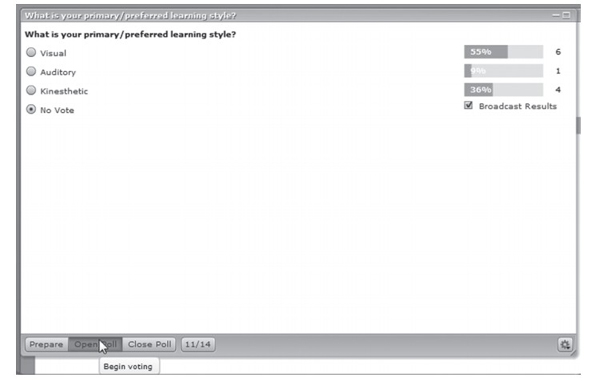
Source: Adobe® product screenshot reprinted with permission from Adobe Systems Incorporated
Some virtual classroom software programs allow you to create polls ahead of time and store them as separate files that can be uploaded to the classroom when needed. In other programs, you may need to type in the poll questions and answers as part of your day-of-class setup.
Raise Hand/Change Status. Description: Participants have the ability to communicate with the trainer by changing their status or raising their hand (see Figure 4-7). When someone clicks on this command, the trainer sees a small icon next to the participants' name indicating their status.
Common uses: This feature is often used for responding to closed-ended questions and quick yes/no polls. For example, a trainer might ask, "Who has seen this feature before? If you have, please 'raise your hand.'"
A trainer could also inform participants that raising their hands is one way to ask a question during class. When someone clicks on the "raise your hand" option, the trainer will call on him or her to speak.
In the virtual classroom software programs that offer more options than just raising your hand, this feature can also be used for more advanced polling. Participants can choose to agree or disagree with a statement, or respond "yes" or "no." This feature could also provide pacing feedback to the trainer (such as "speed up" or "slow down").
Figure 4–7. Raise Hand/Change Status Menu in Adobe Acrobat Connect Pro
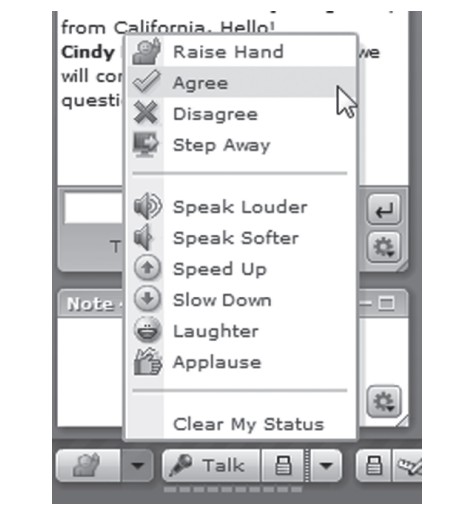
Source: Adobe® product screenshot reprinted with permission from Adobe Systems Incorporated
Unique characteristics: In some programs, only the host and presenter can see the status change or "vote" of the participants. Other programs allow everyone to see the hand raised or status change.
Breakout Groups. Description: Breakout groups mimic small group activities in the face-to-face classroom (see Figure 4-8). If the trainer wants all participants to divide into smaller groups to complete a learning exercise such as a skills practice or brainstorm activity, then the trainer would assign participants to a breakout group. For example, a class with 15 participants might split into three teams of five people each.
In the virtual classroom, it's the same thing: The trainer would divide the class into smaller groups and then activate the breakouts. Participants move into a virtual private meeting room where they only hear their private conversation. They can share documents and whiteboards among themselves and collaborate together. The trainer has the ability to move in and out of the breakouts, just like he or she would walk around the room in a face-to-face session.
Common uses: Breakout groups can be used to practice skills learned during the training event. For example, if the class learns techniques for how to start a coaching conversation with an employee, the individuals could practice those techniques in a small group setting. In a practice breakout, one participant could practice the new coaching skill, another participant could be on the receiving end of the practice, and a third participant could be the silent observer. The participants could then rotate roles, each having a chance to practice the new coaching skill.
Figure 4–8. Breakout Rooms in Adobe Acrobat Connect Pro

Source: Adobe® product screenshot reprinted with permission from Adobe Systems Incorporated
Another common use of breakouts is for small group brainstorming. Different groups could discuss different aspects of the same situation, or they could each discuss a different situation. You could even have the groups all discuss the same situation and then compare notes afterward.
In addition, any time you need to maximize participation, you might consider using breakout groups. These private collaboration sessions involve every participant because it's much tougher to "hide" in a small group. In other words, if you assign three participants to complete a group task versus assigning 15 participants to complete a group task, participants in the smaller group may be more likely to engage in the activity.
Unique characteristics: The audio choice in use during the virtual event will dictate how the audio functions in the breakout. In other words, if you are using the virtual classroom software's VoIP integrated audio, then when you create the breakout groups, the audio will automatically update. Participants in a small group will only be able to hear each other, as if they were on their own private line. However, if you use a separate conference calling line for the audio, then participants will need to manually move into their audio breakouts.
The number of breakout rooms available depends upon the virtual classroom software you're using. For example, Adobe Acrobat Connect Pro currently has a limit of five breakout rooms at one time.
On the conference call provider I use most, I sign into the conference call as the moderator and press *21 to activate the audio breakout groups. Then when it is time for participants to break out, they press # and their group number on the telephone. At the end of the activity, they press ## on their telephone to rejoin the main line. As the moderator, I can press #0 to "force" everyone back to the main group.
Application Sharing. Description: Application sharing allows trainers to open up their computer, specifically a certain software program, web browser, or desktop, to the participants (see Figure 4-9). Trainers select which application will be shared, and then participants will visually see it on their screen. When the trainer navigates through the program, participants follow along.
Figure 4–9. Menu Command to Access Desktop Sharing in Adobe Acrobat Connect Pro
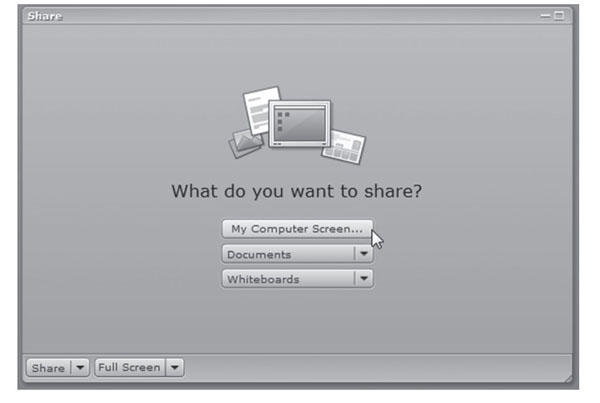
Source: Adobe® product screenshot reprinted with permission from Adobe Systems Incorporated
If the trainer shares her desktop, then the participants will view the trainer's computer, including all keyboard typing, mouse movements, and switching between programs. If the trainer shares a web browser, then the participants will see the trainer navigating the Internet. If the trainer shares a software program, then the participants will see just that one program.
The main difference between sharing your desktop and sharing just an application (either a software program or a web browser) is that when you choose to share your desktop, participants see everything. They will see your desktop's wallpaper, icons, and everything else you do on your computer. This feature can be useful if that's your goal. However, it is too revealing if you only want them to see one software program or just your web browser window.
A separate but related feature available in most virtual classroom software programs is a shared remote control. A participant can be given control of the mouse pointer so that they can navigate and edit in the shared application. This can be useful during software training when you want a participant to gain hands-on experience with the program. The participant can use the remote control to practice a new skill learned. However, most programs only allow one person to be in control, so large classes might not benefit from taking turns one at a time.
Common uses: You could use application sharing when you need to display a file that is not supported by the virtual classroom program's document sharing. You could also use application sharing when you need to edit documents during class. For example, if you are demonstrating how to enter text into a file, then you would need to have the file open in editing mode, which is another way to think of application sharing. Perhaps the most common use of application sharing is when you are conducting software training in the virtual classroom. With application sharing, the software program becomes visible to all participants.
Unique characteristics: There is often a lag time between the time the trainer selects the "share application" or "share desktop" command and when the participants see the trainer's screen. During this pause, let participants know that it might take a few moments so that they don't think something is wrong with their screen.
Some virtual classroom software programs distinguish between desktop sharing, application sharing, and web browser sharing with separate tools for each. Other virtual classroom software programs combine these options into one command.
 |
Noted: |
Become an expert on the software. You can't be an expert just by using it once a month. I used online meeting software for all my remote meetings, not just training. This forced me to really know the tool inside and out…. Great facilitators of in-person classes who do very few online facilitations just don't get comfortable enough with the software to transfer those great facilitation skills. You must know the tool. Attend all the training. Understand what every button does and when you would use it and when you would not. The biggest failure of online trainers is just not knowing the tool. It reflects badly on the course content and the experience.
—Mike Abrams, CEO, Resulting Idea, LLC

Getting It Done
It is critically important for you to know your software tools inside and out. A unique characteristic could be that the tool is only available under certain circumstances. For example, the annotation tools may not be visible to participants if they have not been granted privileges to use them. Or, the "assign breakout" command might only be available after you have clicked on a participant's name. Mastering your virtual classroom software means knowing every command and when each command can be used.
Mastering the software also means knowing it from the presenter's perspective and from the participant's perspective. The participant's screen will not look exactly the same as yours. For example, the participants may see a "raise hand" button, while the presenter sees a "make presenter" button in its place. As the host or presenter, you will often need to teach participants how the virtual classroom software works, and therefore, you need to know it from their point of view.
Finally, it's not enough to just read how tools work in an online help screen or user manual. You have to try them out yourself. There may be an undocumented quirk, or something about the feature that works in a way you didn't expect it to do so. Practice using the software so that you master it. Complete Worksheet 4-1 to determine which technology skills you want to learn more about.
Worksheet 4–1: Checklist for Learning Virtual Classroom Software
Use the following questions to organize your notes while learning a virtual classroom software program.
Name of virtual classroom software:
Which version?
Who is hosting the virtual classroom software?
Vendor
|
|
Third party
|
|
Other
|
What sources of tech support for your virtual classroom software are available (such as via telephone, web, classes, dedicated tech support, and so on)?
Use the following checklist to track your learning:
| Feature | Unique Characteristics |
|---|---|
| Sharing Documents |
|
| Chat |
|
| Annotation |
|
| Whiteboard |
|
| Polling |
|
| Raise Hand/Change Status |
|
| Breakout Groups |
|
| Application Sharing | |
| List other features here: | |
Other notes about learning the software:
